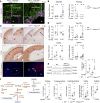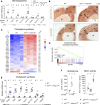PKA signaling drives reticularis differentiation and sexually dimorphic adrenal cortex renewal
- PMID: 29367455
- PMCID: PMC5821213
- DOI: 10.1172/jci.insight.98394
PKA signaling drives reticularis differentiation and sexually dimorphic adrenal cortex renewal
Abstract
The adrenal cortex undergoes remodeling during fetal and postnatal life. How zona reticularis emerges in the postnatal gland to support adrenarche, a process whereby higher primates increase prepubertal androgen secretion, is unknown. Using cell-fate mapping and gene deletion studies in mice, we show that activation of PKA has no effect on the fetal cortex, while it accelerates regeneration of the adult cortex, triggers zona fasciculata differentiation that is subsequently converted into a functional reticularis-like zone, and drives hypersecretion syndromes. Remarkably, PKA effects are influenced by sex. Indeed, testicular androgens increase WNT signaling that antagonizes PKA, leading to slower adrenocortical cell turnover and delayed phenotype whereas gonadectomy sensitizes males to hypercorticism and reticularis-like formation. Thus, reticularis results from ultimate centripetal conversion of adult cortex under the combined effects of PKA and cell turnover that dictate organ size. We show that PKA-induced progenitor recruitment is sexually dimorphic and may provide a paradigm for overrepresentation of women in adrenal diseases.
Keywords: Development; Endocrinology; Genetic diseases; Mouse models; Protein kinases.
Conflict of interest statement
Figures







Similar articles
-
Adrenocortical development: Lessons from mouse models.Ann Endocrinol (Paris). 2018 Jun;79(3):95-97. doi: 10.1016/j.ando.2018.03.014. Epub 2018 Apr 16. Ann Endocrinol (Paris). 2018. PMID: 29673697
-
Adrenal androgens, adrenarche, and zona reticularis: A human affair?Mol Cell Endocrinol. 2021 May 15;528:111239. doi: 10.1016/j.mce.2021.111239. Epub 2021 Mar 4. Mol Cell Endocrinol. 2021. PMID: 33676986 Review.
-
Development of adrenal cortex zonation.Endocrinol Metab Clin North Am. 2015 Jun;44(2):243-74. doi: 10.1016/j.ecl.2015.02.001. Endocrinol Metab Clin North Am. 2015. PMID: 26038200 Free PMC article. Review.
-
PKA inhibits WNT signalling in adrenal cortex zonation and prevents malignant tumour development.Nat Commun. 2016 Sep 14;7:12751. doi: 10.1038/ncomms12751. Nat Commun. 2016. PMID: 27624192 Free PMC article.
-
The zona reticularis is the site of biosynthesis of dehydroepiandrosterone and dehydroepiandrosterone sulfate in the adult human adrenal cortex resulting from its low expression of 3 beta-hydroxysteroid dehydrogenase.J Clin Endocrinol Metab. 1996 Oct;81(10):3558-65. doi: 10.1210/jcem.81.10.8855801. J Clin Endocrinol Metab. 1996. PMID: 8855801
Cited by
-
Bilateral Adrenal Hyperplasia: Pathogenesis and Treatment.Biomedicines. 2021 Oct 5;9(10):1397. doi: 10.3390/biomedicines9101397. Biomedicines. 2021. PMID: 34680514 Free PMC article. Review.
-
A ZNRF3-dependent Wnt/β-catenin signaling gradient is required for adrenal homeostasis.Genes Dev. 2019 Feb 1;33(3-4):209-220. doi: 10.1101/gad.317412.118. Epub 2019 Jan 28. Genes Dev. 2019. PMID: 30692207 Free PMC article.
-
NR5A1 and cell population heterogeneity: Insights into developmental and functional disparities and regulatory mechanisms.Reprod Med Biol. 2025 Feb 17;24(1):e12621. doi: 10.1002/rmb2.12621. eCollection 2025 Jan-Dec. Reprod Med Biol. 2025. PMID: 39968346 Free PMC article. Review.
-
Effect of Inactivation of Mst1 and Mst2 in the Mouse Adrenal Cortex.J Endocr Soc. 2022 Sep 16;7(1):bvac143. doi: 10.1210/jendso/bvac143. eCollection 2022 Nov 17. J Endocr Soc. 2022. PMID: 36405866 Free PMC article.
-
Cellular Senescence in Adrenocortical Biology and Its Disorders.Cells. 2021 Dec 9;10(12):3474. doi: 10.3390/cells10123474. Cells. 2021. PMID: 34943980 Free PMC article. Review.
References
-
- Mesiano S, Jaffe RB. Developmental and functional biology of the primate fetal adrenal cortex. Endocr Rev. 1997;18(3):378–403. - PubMed
Publication types
MeSH terms
Substances
Grants and funding
LinkOut - more resources
Full Text Sources
Other Literature Sources
Molecular Biology Databases

